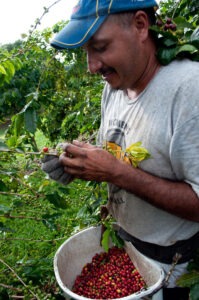Autumn Harvest Season On A Kona Coffee Farm
The sun is setting earlier and rising later. The birds are starting to migrate to warmer climes. Somehow the air feels different and the nights are getting a bit nippy. Acorns are falling and mushrooms are pushing their way up through the forest floor. The Maple leaves are just starting to change. Then your partner looks over lovingly and says, “Pumpkin Pie Spice Latte?” Autumn has arrived.
Honestly speaking, everything I just described above is from memory. Here in Kona, Hawaii, although there are subtle temperature variations, and the days do get shorter, everything else is pretty much the same. We still swim in the ocean, watch sunsets, chase rainbows, and otherwise enjoy daytime temperatures in the mid-80s. In the Kona Coffee Belt, however, autumn is crazy busy with the coffee harvest.
The Coffee Schedule
An interesting, little known, historical fact is that schools in Kona, Hawaii were mandated to have summer vacation from mid-August to November. This was known as the “Coffee Schedule” and was the only school schedule dictated by an agricultural crop in the territory of Hawaii. This practice continued right up to 1969, ten years into statehood. The purpose, of course, was that students would be available to help their families pick coffee during the autumn harvest season. As you can imagine, the students themselves were not so thrilled with this system, but it really was an “all hands on deck situation.”
Autumn in Kona, Hawaii
Here in Kona, autumn is picking season for coffee farmers. September through November is the peak of the coffee harvest. Friends who own 5-8 acre farms frantically get the whole family involved getting the coffee off of the trees before it goes bad. Large operations like Greenwell Farms have 40+ people picking every day. Remember, all Kona Coffee is hand-picked.
 Because we are a processing facility as well as a farm, we have a double whammy. We pick and process our own coffee cherry and we also buy and process a large portion (a quarter plus) of all Kona Coffee grown.
Because we are a processing facility as well as a farm, we have a double whammy. We pick and process our own coffee cherry and we also buy and process a large portion (a quarter plus) of all Kona Coffee grown.
The coffee cherries are all weighed, inspected, and graded. Then, they are run through color scanners to remove any under or overripe fruits and then pulped.
Pulping is where we separate the skin and seed. We allow the seeds to ferment just enough to be able to rinse off the mucilage, and then lay the coffee up on our sun decks to dry. We call the coffee at this stage, parchment.
Wet Mill to Dry Mill
Each batch is numbered and tracked, raked every 30 minutes or so during the day, and takes about 6-7 days of full sun to reduce the moisture content of the individual beans to somewhere between 10 and 11%. This is an important number for coffee parchment that prevents the seed from sprouting and keeps at bay any toxic molds that want to grow on the coffee.
Once the parchment is stable, we will let it rest for a while. Known as “reposing”, this month-long rest allows the coffee bean to mellow and lets the moisture evenly disperse throughout the bean. This protects against unwanted flavors by strengthening the cell wall which also allows the final roasted coffee to age better.
Then, we send the parchment in 1,000-pound grain-pro bags over to the dry-mill. Here, by machine, the parchment is hulled (removing the outer skin), gently polished to remove the secondary silver skin, and then size sorted.
As regulated by law, Kona Coffee grades are separated into Type I and Type II beans. Type one is two hemispheric seed halves per fruit. Type II means a single rounded bean per fruit, also known as Peaberry.
Size Matters
After polishing, beans are sorted by actual size. #19, #18, #16 refer to 19/64ths of an inch, 18/64ths of an inch, and so on. The screen grates in the classifier are gauged to these sizes and anything smaller than 16/64ths of an inch goes into another category.
Consistency in the size of the bean has a great impact on roasting and well-sorted coffee will always pay off in the cup. For example, when you chop a carrot into different sized pieces and then saute them, the smaller pieces will cook faster than the larger pieces. In the same way, different sized coffee beans cooked together will roast differently. A uniform roast will always be better, as the individual flavor notes will sing together in harmony rather than a discordant cacophony of tastes from randomly roasted beans.
Now it is time to remove as many defective beans as we can. First, the gravity table sorts the beans by density, taking out any beans that might be porous or bug damaged. Finally, the optical sorter will remove any seeds with an off-color or shape.
The end result is some of the finest processed green coffee beans anywhere in the world. The beans have to be USDA certified before they can leave Hawaii, and that is where size designations take on more elegant names like Extra Fancy, Fancy, Select, Number One, Peaberry, and Prime.
Headed to Your Cup
In our case, the lion’s share of this green bean coffee is sent to Oakland, California, and then distributed to roasters across the country who have contracted for our 100% Kona Coffee. They will roast and use that coffee according to their needs and once they roast it, they can put their name on that coffee.
The remaining percentage and all of our estate coffees are stored as green bean on-site. This is sent to the roaster twice a week to create our Greenwell Farms roasted coffee that we sell at our retail store here in Kona and online.
On Average, Kona produces roughly 2.7 million pounds of green coffee beans. While every year is different, we are processing just over a quarter of that amount. Several million pounds of coffee cherry will move through our facility each year.
It truly is an incredible process. Start with a unique growing climate, fill it with the best varietals, keep them as healthy and productive as possible, and then process those beans to the highest gourmet standards.
While that 2.7 million pounds of green bean may seem like a lot, it is less than a tenth of one percent of the world’s coffee supply.
Also Read: Getting the most of your Kona coffee
Catching Your Breath
Keep in mind that while autumn (Sept-Nov) is the peak of our season, harvest starts in July and continues through February. After harvest, a total cleaning and pruning of the farm takes place, which lasts for months. Dry milling and roasting continue all year.
Our quality control experts “cup” and “describe” the new coffee and assure it is up to standards and being roasted perfectly. Land clearing, new plantings, grafting and growing the young trees in the nursery, ongoing programs of fertilization and pest control mean that while there is a crazy busy time of year (autumn), there never really is a downtime.
Around mid-June, just as we are catching our breath, feeling the first hints of summer, the initial signs of new red coffee cherry begin to show, and we do it all again.

Matt Carter is a retired teacher (1989-2018), part-time musician, farmer, and currently manages Greenwell Farm’s Tour and Retail Store Operations.






